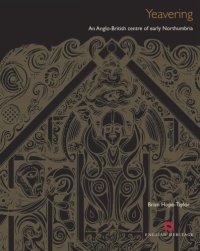
Ebook: Yeavering: An Anglo-British Centre of Early Northumbria
Author: Brian Hope-Taylor
- Genre: History // Archaeology
- Year: 2009
- Publisher: English Heritage
- City: Swindon
- Edition: 2nd
- Language: English
- pdf
First published 1977 as "Archaeological report no. 7" by Her Majesty's Stationary Office for the Department of the Environment. Reprinted with corrections 2009.
This volume - originally published in 1977 and long out-of-print, but still in demand - describes the excavation of a site near Wooler in Northumberland which is identified with the place called Ad Gefrin by the Venerable Bede. There, Edwin of Northumbria had a northern palace; and there Paulinus, his Roman missionary, achieved mass-conversions. Excavation showed that the roots of Ad Gefrin stretched further back in time. The site was used as a cremation cemetery from about 2000 BC. Put under the plough, at or after the time that a British oppidum was established on an overlooking hill, it was still receiving cremations during the Roman Iron Age. Then, or slightly later, the first element of the future township was established: a palisaded enclosure rebuilt repeatedly (finally by Edwin himself). By the sixth century a little mortuary enclosure or "shrine", its inhumations clustered round the focus of the prehistoric cremation cemetery, had been replaced by what appears to have been a pagan temple. That, preserved as part of Edwin's township, was closely followed by a wooden "theatre" for formal assemblies (which outlived Edwin). The series of royal halls so closely studied here then began: Edwin's was the greatest, but it was neither the first nor the last.
Techniques of excavation were evolved specially to allow the precise recovery of the details of vanished wooden structures. The author showed that archaeological enquiries into historical periods must, both in questions and answers, also serve the needs of students of written evidence. There has been much scholarly reinterpretation of the original results, but the volume stands as a record of that work.
This volume - originally published in 1977 and long out-of-print, but still in demand - describes the excavation of a site near Wooler in Northumberland which is identified with the place called Ad Gefrin by the Venerable Bede. There, Edwin of Northumbria had a northern palace; and there Paulinus, his Roman missionary, achieved mass-conversions. Excavation showed that the roots of Ad Gefrin stretched further back in time. The site was used as a cremation cemetery from about 2000 BC. Put under the plough, at or after the time that a British oppidum was established on an overlooking hill, it was still receiving cremations during the Roman Iron Age. Then, or slightly later, the first element of the future township was established: a palisaded enclosure rebuilt repeatedly (finally by Edwin himself). By the sixth century a little mortuary enclosure or "shrine", its inhumations clustered round the focus of the prehistoric cremation cemetery, had been replaced by what appears to have been a pagan temple. That, preserved as part of Edwin's township, was closely followed by a wooden "theatre" for formal assemblies (which outlived Edwin). The series of royal halls so closely studied here then began: Edwin's was the greatest, but it was neither the first nor the last.
Techniques of excavation were evolved specially to allow the precise recovery of the details of vanished wooden structures. The author showed that archaeological enquiries into historical periods must, both in questions and answers, also serve the needs of students of written evidence. There has been much scholarly reinterpretation of the original results, but the volume stands as a record of that work.
Download the book Yeavering: An Anglo-British Centre of Early Northumbria for free or read online
Continue reading on any device:

Last viewed books
Related books
{related-news}
Comments (0)